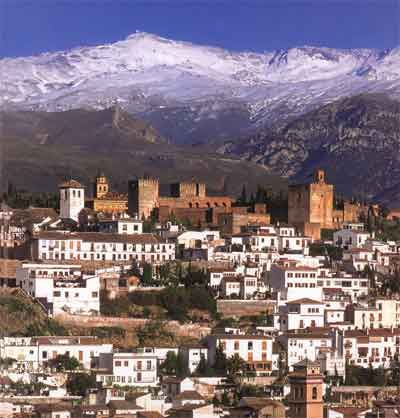| |


Vuelta a Espana 05 (Click to enlarge)

Stage 1 ITT. Granada and the Alhambra

| |
Vuelta Travelogue - Quintessential Spain
La Vuelta a Espana: A Grand Tour [Part 1]
After 700 years of Moorish rule, Spain succumbed to the Christian Reconquest when Ferdinand and Isabella finally conquered Granada in 1492 and created a united Spain. Islamic rule was replaced by Christian rule, but today relics of the Moors permeate the culture, architecture and the very soul of Andalucia, the region where this year's Vuelta begins.
Along with Cordoba and Sevilla, Granada belongs to the trio of romantic Moorish cities that evoke images of quintessential Spain: bullfights, flamenco, brown hills dotted with olive, lemon, orange and wine groves and, of course, romantic castles. Yet 1,000 years before the Moors, the Romans occupied Spain. There is still evidence of that great culture in abundance with bridges, aqueducts and buildings to be seen everywhere.
These musings may seem to have little to do with cycle racing in general and the Vuelta a Espana in particular. However it takes little imagination to recognize that the architects of the grand Tours utilize the history, culture and infinite variations in geographical features of their beautiful countries to design races that become an integral part of their society. Probably no other sport is woven so intimately into the fabric of its homelands.
Homage to Spain
This year's route touches on the very core of this fascinating country. On day one, a 7 km time trial takes the riders from the old town of Granada to the incomparable Alhambra and Generalife on the crest of the La Sabica hill that dominates the town. The Alhambra was the very last stronghold of the Moorish rulers in Spain and today its ornate architecture draws visitors from around the world. A combination of alcazaba (fortress), alcazar (palace) and medina (city), the Alhambra incorporates some incredibly beautiful courtyards and rooms unique in Europe. The nearby Generalife was built as a playground for the Nasrite emirs. Its combination of trees, formal gardens, miradors and galleries conspire to build an atmosphere of peace with intoxicating perfumes from the vegetation and the sounds of water to massage the senses.
Completing the magic of Granada is its proximity to the Sierra Nevada mountain range. Whether it is dawn, dusk or during the glaring sunlit heat of the mid-day, the Sierra Nevada's snow-capped peaks provide a breathtaking backdrop to the ancient architecture of Granada and the Alhambra.
Stage 2 of the Vuelta will take the riders along parched roads and past many of the famous Andalucian Pueblos Blancos (White Towns) on their way to Córdoba. While not mountainous, the 189.3 km route is certainly not flat. In 929, Córdoba was declared an independent caliphate, separate from Baghdad, and became the Moorish capital. The Christians retook it in 1236. While the riders rest between stages, many of the Vuelta race entourage will enjoy meandering the old quarter with its narrow whitewashed streets and geraniums tumbling out of flower boxes at every turn. Dominating the city is the Islamic mosque, which has the strange feature of a Christian cathedral inserted in its core. |
|
